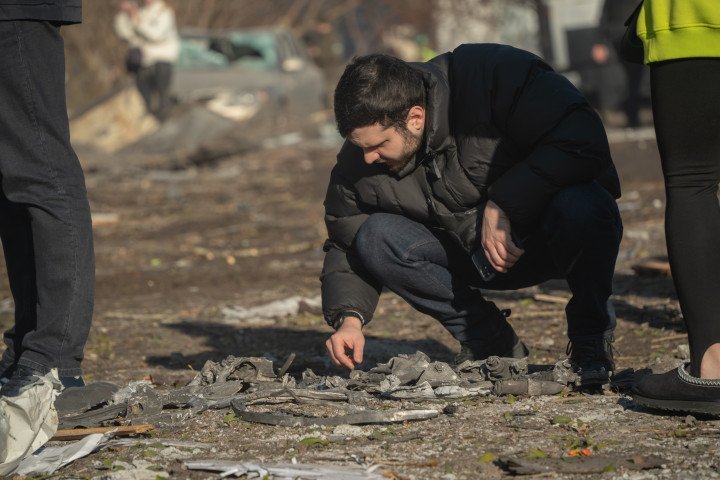- Category
- War in Ukraine
How Russia Builds Its Deadliest Iskander Missiles Using Western Technology

As Europe ramps up rearmament and defense spending to counter Russia’s aggression, another battle is just as critical: stopping Moscow from using Western technology to build its deadliest weapons. Despite sanctions, Russia still acquires dual-use equipment from Ukraine’s allies.
European Commission President Ursula von der Leyen unveiled on March 4 a five-step plan for Europe’s rearmament and support for Ukraine, amounting to €800 billion. Europe is now entering “an era of rearmament,” she said.
Russia, however, embarked on its rearmament journey more than a decade ago—largely thanks to technology from Ukraine’s allies. The remnants of the Soviet Union’s production base had largely collapsed, but Russia managed not only to revive Soviet-era military equipment but also to develop and complete more modern weapon systems.
One of the most dangerous ballistic missiles in Russia’s arsenal is the Iskander-M, which has been used to attack Ukrainian cities for over three years. Its production depends heavily on Western technology. A key role is played by computer numerical control (CNC) machines sourced from the US, Europe, and Asia, according to research by the Economic Security Council.

At least 12 enterprises involved in the production of 9M723 missiles for the Iskander-M system use foreign machinery and components. These include brands such as Agie Charmilles (Switzerland), DMG Mori and Walter Maschinenbau (Germany), Aman and Baofeng (China), Sodick (Japan), Accuway (Taiwan), Comagrav (Czechia), Romi S.A. (Brazil), Trens SK (Slovakia), Tarso (US), and Hwacheon (South Korea).
Some of this equipment was acquired after Russia’s full-scale invasion of Ukraine. In March 2022, Russian state defense enterprise KB Mashinostroyeniya or KBM (“lit. “Machine-Building Design Bureau”)—the primary developer and manufacturer of the Iskander-M ballistic missile—purchased a Taiwanese Accuway clamping cylinder, a German BDS Maschinen magnetic drilling machine, and a German Heidenhain rotary position sensor.
In May 2022, Russia’s Federal Center for Dual-Use Technologies "Soyuz," which developed the launch engine and solid-fuel charge for the Iskander-M, acquired a screw-cutting lathe.
Iskander-M production has always depended on foreign technology
The Iskander-M system was initially developed during the Soviet era, but it was only adopted into service in 2006. That same year, Russia decided to begin serial production of the 9M723 missile at its Votkinsk Machine Building Plant. However, due to outdated equipment and the concurrent production of other missile systems, such as the Topol-M and Bulava, the plant struggled to meet production targets.
To address the issue, the Russian government launched a modernization effort in 2009. Out of the 314.34 million rubles ($3.5 million) allocated for the upgrade, nearly half (46.3%) was spent on purchasing imported CNC machines. Russia acquired equipment from brands such as Strojtios and TOS Varnsdorf (Czechia), Hermle and Trumpf (Germany), EMCO and Fronius (Austria), Struers and Triventek (Denmark), Transmille (UK), and Innov-X Systems (US). Russia didn’t just use foreign machines—it built its entire Iskander production around them.
“During 2024 and early 2025, the state of the production capacity of the Russian MIC (military-industrial complex) has been at a similar level to 2009,” the Economic Security Council said. “The production capacity of the Russian MIC is operating at a record high of 84%. 63-65% of all Russian capital equipment in the military and related industries is worn out, which is also confirmed by former employees of Russian enterprises involved in the production of components for Iskander-M.”
So, if access to imported equipment is blocked, the Votkinsk Plant will once again fail to meet its defense orders, just as it did two decades ago.
How Russia still gets critical Iskander-M tech despite sanctions
In 2023, Ukraine’s allies intensified efforts to cut off Russia’s access to CNC machines, with EU sanctions imposing strict bans on exports and re-exports of such equipment to Russia. Yet, Moscow continues to find new ways to secure critical manufacturing tools.
Russia employs various methods, from purchasing second-hand equipment to securing direct supplies, primarily from Asian countries. Between January 2023 and July 2024, the Kremlin acquired more than 22,000 CNC machines worth over $4.16 billion, along with $1.1 billion in components and $12.8 billion in consumables, according to the Economic Security Council.

China remains Russia’s largest supplier of CNC technology, accounting for 80-90% of imports. Despite Beijing’s close ties with Moscow, Chinese equipment remains vulnerable to potential Western restrictions, as it incorporates technologies and components from sanctioning countries.
However, these restrictions have not fully extended to subsidiaries of European manufacturers operating in third countries such as Türkiye, China, India, and Malaysia.
Between January 2023 and July 2024, Russia acquired at least 57 CNC machines worth over $26.5 million, as well as components, consumables, and software worth $9.5 million—all produced by subsidiaries of European brands.
To further restrict Russia’s access to such equipment and weaken its defense industry, the Economic Security Council recommends additional sanctions from Ukraine’s allies, including:
Terminating the transfer of R&D, technology, and components to Chinese manufacturers of CNC equipment that export their products to Russia, namely Russian military-industrial enterprises.
Obliging Western manufacturers of CNC equipment and related components to thoroughly vet their Chinese customers and terminate or freeze cooperation with those doing business with Russia.
Obliging Western manufacturers to conduct their own or independent regular (quarterly) audits of their products entering the Russian market, investigate all cases of such entry, and report on the basis of the audits to the competent authorities, as well as to their shareholders and distribution networks.
Prohibiting the export, re-export, and transit through Russian territory of Western components, raw materials, and software to Russia as part of a final product manufactured in a third country. This primarily concerns Western-made CNC control units, which are used in most Chinese machine tools that enter Russia.
For a full report and recommendations, refer to the Economic Security Council’s attached study.
-206008aed5f329e86c52788e3e423f23.jpg)

-f88628fa403b11af0b72ec7b062ce954.jpeg)
-b63fc610dd4af1b737643522d6baf184.jpg)


-29a1a43aba23f9bb779a1ac8b98d2121.jpeg)

-24deccd511006ba79cfc4d798c6c2ef5.jpeg)